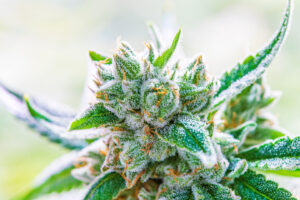TL;DR:
 Terpenes are organic compounds in cannabis responsible for its unique aromas and flavors. They play a crucial role in the plant’s defense and contribute significantly to the overall cannabis experience. Different strains have varying terpene profiles, influencing their effects, flavors, and potential therapeutic benefits like pain relief and anxiety reduction. Terpenes also work with cannabinoids through the “entourage effect,” enhancing the impact of cannabis. Understanding and experimenting with terpene profiles can help you find the best strains for your personal needs.
Terpenes are organic compounds in cannabis responsible for its unique aromas and flavors. They play a crucial role in the plant’s defense and contribute significantly to the overall cannabis experience. Different strains have varying terpene profiles, influencing their effects, flavors, and potential therapeutic benefits like pain relief and anxiety reduction. Terpenes also work with cannabinoids through the “entourage effect,” enhancing the impact of cannabis. Understanding and experimenting with terpene profiles can help you find the best strains for your personal needs.
Introduction to Terpenes
Definition of Terpenes
Terpenes are naturally occurring organic compounds found in many plants, including fruits, herbs, and flowers. They are most well-known for giving plants their unique aromas and flavors. In cannabis, terpenes are responsible for the diverse scents and tastes of different strains, making them a key component in the overall sensory experience. These compounds also contribute to the plant’s therapeutic properties, adding another layer to the effects cannabis users may experience.
Role in Nature
In nature, terpenes play a crucial role in the survival of plants. They serve as a natural defense mechanism by deterring pests and herbivores with strong aromas or bitter tastes. On the flip side, they attract pollinators, helping plants reproduce. This protective function helps plants thrive in their environments and can vary based on the plant’s habitat, which is why different plants (and cannabis strains) have distinct terpene profiles.
Importance in Cannabis
 In the cannabis community, terpenes are gaining significant attention for their role beyond just providing pleasant aromas. While cannabinoids like THC and CBD have long been the focus of cannabis effects, terpenes add another layer of influence. They work in combination with cannabinoids to shape the overall effects of each strain. For instance, two strains with similar THC levels may produce different experiences due to their unique terpene profiles. As research grows, more cannabis users are exploring terpene profiles to enhance their experience, whether they’re seeking relaxation, focus, or mood elevation.
In the cannabis community, terpenes are gaining significant attention for their role beyond just providing pleasant aromas. While cannabinoids like THC and CBD have long been the focus of cannabis effects, terpenes add another layer of influence. They work in combination with cannabinoids to shape the overall effects of each strain. For instance, two strains with similar THC levels may produce different experiences due to their unique terpene profiles. As research grows, more cannabis users are exploring terpene profiles to enhance their experience, whether they’re seeking relaxation, focus, or mood elevation.
Types of Terpenes Found in Cannabis
- Common Terpenes
Cannabis contains a wide variety of terpenes, each contributing to its unique aroma, flavor, and effects. Here are some of the most common terpenes found in cannabis: - Myrcene
Known for its earthy, musky aroma, myrcene is often found in Indica strains. It is believed to promote calming effects and is commonly associated with the relaxing and sedative properties of cannabis. - Limonene
With a distinct citrus scent, limonene is recognized for its uplifting and mood-boosting effects. It’s typically found in Sativa strains and is associated with an energizing and refreshing experience. - Linalool
Linalool brings a floral, lavender-like aroma to the table and is best known for its calming and anti-anxiety properties. This terpene is often found in strains used for relaxation and stress relief. - Pinene
As its name suggests, pinene has a sharp, pine-like aroma and is found in many cannabis strains. It is believed to have cognitive benefits, such as aiding memory retention and alertness, while also providing anti-inflammatory properties. - Caryophyllene
With a spicy, peppery scent, caryophyllene stands out as the only terpene known to interact directly with the body’s endocannabinoid system. It’s often praised for its potential anti-inflammatory and pain-relieving effects, making it a valuable component in medicinal strains.
How Terpenes Vary Between Strains
 Each cannabis strain contains a unique combination of terpenes, contributing to its distinct flavor, aroma, and effects. These terpene profiles can vary widely, even among strains with similar cannabinoid levels. For example, one strain might have a dominant citrus aroma due to high levels of limonene, while another may have a woody, earthy scent because of myrcene and pinene. These terpene variations influence not only the sensory experience but also the potential therapeutic effects, allowing consumers to tailor their choices based on both preference and desired outcomes.
Each cannabis strain contains a unique combination of terpenes, contributing to its distinct flavor, aroma, and effects. These terpene profiles can vary widely, even among strains with similar cannabinoid levels. For example, one strain might have a dominant citrus aroma due to high levels of limonene, while another may have a woody, earthy scent because of myrcene and pinene. These terpene variations influence not only the sensory experience but also the potential therapeutic effects, allowing consumers to tailor their choices based on both preference and desired outcomes.
Terpenes and the Entourage Effect
What Is the Entourage Effect?
The entourage effect refers to the synergistic relationship between cannabinoids (such as THC and CBD) and terpenes, suggesting that when consumed together, they create enhanced or more balanced effects than when taken in isolation. This phenomenon has gained significant attention in the cannabis community, as researchers believe that the various compounds in cannabis work better as a team, influencing how the body experiences their benefits.
While THC and CBD often steal the spotlight for their psychoactive and medicinal properties, terpenes are critical in shaping the overall effects of cannabis. By interacting with cannabinoids, terpenes help modulate the intensity, duration, and specific outcomes of cannabis consumption. This synergy offers consumers a more nuanced and tailored experience, whether they seek relaxation, pain relief, or mental clarity.
Examples of Terpene-Cannabinoid Interaction
Certain terpenes can enhance or alter the effects of cannabinoids, adding layers to the cannabis experience. Here are some key examples of how terpenes work with cannabinoids to influence effects:
- Linalool and CBD (Calming Synergy)
Linalool, known for its calming and anti-anxiety properties, can amplify the soothing effects of CBD. When these two compounds work together, they may offer heightened relaxation and stress relief, making them ideal for reducing anxiety, insomnia, or general tension. - Myrcene and THC (Relaxation and Sedation)
Myrcene, a terpene commonly associated with Indica strains, is known for its sedative properties. When paired with THC, myrcene can help deepen the relaxing, couch-lock effects of the strain, promoting a restful experience for those seeking relief from insomnia or chronic pain. - Pinene and THC (Alertness and Focus)
Pinene, with its sharp, pine-like aroma, has been associated with increased alertness and memory retention. When combined with THC, pinene may help counteract some of the short-term memory impairment caused by THC, offering a more balanced experience that enhances focus without sacrificing the psychoactive effects. - Caryophyllene and CBD (Pain Relief and Inflammation)
Caryophyllene’s unique interaction with the endocannabinoid system makes it particularly valuable in combination with CBD. Together, these compounds may boost anti-inflammatory and analgesic effects, making this combination ideal for individuals managing chronic pain or inflammatory conditions.
This intricate interplay between terpenes and cannabinoids is why many cannabis users prefer full-spectrum products over isolates. Full-spectrum products retain the plant’s natural mix of terpenes and cannabinoids, offering the benefits of the entourage effect, which isolates (pure THC or CBD) cannot provide.
The Benefits of Terpenes
Potential Therapeutic Effects
Beyond their aromatic contributions to cannabis, terpenes are gaining attention for their potential therapeutic properties. Research has uncovered a variety of health benefits associated with specific terpenes, positioning them as more than just flavor and scent enhancers. Here’s an overview of some notable therapeutic effects of terpenes:
- Anti-inflammatory Effects
Many terpenes exhibit powerful anti-inflammatory properties, making them beneficial for conditions that involve inflammation, such as arthritis or muscle pain. Caryophyllene, for example, is known for its anti-inflammatory effects and unique ability to interact with the body’s endocannabinoid system, which can help reduce pain and swelling. - Anti-anxiety and Stress Relief
Terpenes such as linalool and myrcene are well-known for their calming effects, which can help reduce anxiety and stress. Linalool, commonly found in lavender, is linked to mood enhancement and relaxation, while myrcene promotes sedation and tranquility, making these terpenes ideal for alleviating stress or insomnia. - Pain Relief
Certain terpenes, such as pinene and myrcene, have been shown to offer pain-relieving properties. Pinene, often found in pine trees, can aid in reducing inflammation and alleviating discomfort from conditions like headaches and chronic pain. Myrcene is particularly noted for its muscle relaxant qualities, making it an effective option for those seeking relief from physical pain or tension. - Antioxidant Properties
Some terpenes, including limonene and terpinolene, are packed with antioxidant properties, helping to protect the body from free radical damage. Antioxidants play a crucial role in maintaining cellular health and may reduce the risk of chronic diseases such as heart disease and cancer. The citrus-scented limonene is particularly effective in combating oxidative stress and promoting overall wellness.
While research into the therapeutic potential of terpenes is still in its early stages, the preliminary findings are promising. As interest in holistic medicine grows, terpenes are being recognized for their ability to contribute to overall well-being in ways that go far beyond flavor and aroma.
How Terpenes Impact Your Cannabis Experience
Enhancing the Sensory and Therapeutic Experience
Terpenes play a crucial role in shaping the overall cannabis experience, influencing everything from the flavor and aroma to the specific effects a strain may provide. When you consume cannabis, it’s not just THC or CBD that dictates the experience—terpenes enhance and modify these effects, creating a more personalized and nuanced interaction.
- Flavor and Aroma
The unique combination of terpenes gives each cannabis strain its distinct flavor and scent profile. For example, strains rich in limonene tend to have citrusy notes that can provide an uplifting, energizing effect, while strains high in linalool may offer a more floral aroma and produce calming, soothing sensations. - Effects
Beyond aroma, terpenes can influence the effects you feel. A strain high in myrcene, for example, may help you relax or fall asleep, making it ideal for nighttime use, while a pinene-rich strain might sharpen focus and enhance memory retention, contributing to a more energizing high. - Why Terpene Profiles Matter
Choosing cannabis based on its terpene profile can significantly enhance your personal enjoyment. Knowing which terpenes align with your desired effects—whether you’re seeking relaxation, creativity, or relief from anxiety—can help you select strains that complement your specific goals.
How to Identify Terpenes in Cannabis Products
Reading Product Labels
Many cannabis products now include detailed terpene profiles on their labels, making it easier for consumers to understand the strain’s chemical makeup. Here’s how to make sense of those labels:
- Terpene Content
Look for products that list the terpenes and their concentrations, usually measured in percentages. The dominant terpenes will often be highlighted, giving you insight into the likely aroma and effects of the strain. - Main Terpenes
Some products will focus on specific terpenes such as myrcene, limonene, or caryophyllene. Knowing what each terpene contributes can help you align your choice with your needs, whether it’s for relaxation, mood enhancement, or pain relief.
Aroma and Flavor Testing
Even without a label, you can often identify the dominant terpenes in a cannabis strain through aroma and flavor testing:
- Scent Testing
When you open a jar of cannabis, the first thing you notice is its scent. Strong citrus notes suggest the presence of limonene, while a more earthy, musky smell hints at myrcene. Taking the time to appreciate these aromas can give you an idea of the strain’s effects before you even consume it. - Flavor Testing
Just like fine wines, different cannabis strains offer unique flavor profiles when consumed. Pay attention to the flavors that linger during smoking or vaping—earthy, fruity, spicy, or pine-like notes can indicate the presence of specific terpenes, helping you refine your preferences over time.
By learning to recognize terpenes through both labeling and sensory experiences, you can better tailor your cannabis choices to your personal needs, optimizing both enjoyment and therapeutic effects.
The Growing Importance of Terpenes
As knowledge about cannabis evolves, the role of terpenes has emerged as a key factor in shaping the overall cannabis experience. No longer are consumers solely focused on THC and CBD levels; the distinctive aromas, flavors, and effects brought about by terpenes have taken center stage. This growing awareness has led to a deeper understanding of how terpenes, in synergy with cannabinoids, contribute to the therapeutic and sensory qualities of each strain.
Encourage Experimentation
With this newfound knowledge, it’s time to explore and experiment. By selecting cannabis based on terpene profiles, you can tailor your experience to your personal needs, whether you’re seeking relaxation, enhanced focus, pain relief, or a burst of creative energy. Each strain offers a unique combination of terpenes, and finding the right one can elevate your cannabis journey to a whole new level. So, don’t hesitate to dive in—experiment with different terpene profiles to discover which ones work best for you and enhance your enjoyment of cannabis.





